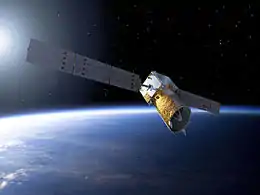ADM-Aeolus
Aeolus, or, in full, Atmospheric Dynamics Mission Aeolus (ADM-Aeolus), is an Earth observation satellite operated by the European Space Agency (ESA). It was built by Airbus Defence and Space and launched on 22 August 2018.[1] ADM-Aeolus is the first satellite with equipment capable of performing global wind-component-profile observation and will provide much-needed information to improve weather forecasting.[3] Aeolus is the first satellite capable of observing what the winds are doing on Earth, from the surface of the planet and into the stratosphere 30 km high.
 Artist's view of Aeolus | |
| Mission type | Weather satellite |
|---|---|
| Operator | ESA |
| COSPAR ID | 2018-066A |
| SATCAT no. | 43600 |
| Mission duration | 3 years (planned) |
| Spacecraft properties | |
| Manufacturer | Airbus Defence and Space |
| Launch mass | 1,366 kg (3,012 lb) |
| Dry mass | 1,200 kg (2,600 lb) |
| Dimensions | 1.74m × 1.9m × 2m |
| Start of mission | |
| Launch date | 22 August 2018, 21:20 UTC[1] |
| Rocket | Vega |
| Launch site | Kourou ELV |
| Contractor | Arianespace |
| Orbital parameters | |
| Reference system | Geocentric |
| Regime | Sun-synchronous |
| Altitude | 320 km (200 mi)[2] |
| Inclination | 97 degrees |
| Repeat interval | 7 days |
| Epoch | Planned |
| Transponders | |
| Band | S band (TT&C support) X band (science data acquisition) |
| Bandwidth | 8 kbit/s download (S band) 10 Mbit/s download (X band) 2kbit /s upload (S band) |
| Instruments | |
| ALADIN (Atmospheric Laser Doppler Instrument) | |
The orbiter was named after Aeolus, a god from the Greek mythology, the ruler of the winds.
Program
The program was initially approved in 1999 for a 2007 launch but technological obstacles caused 11 years of delay, as it was launched on 22 August 2018.[4] For an estimated €481 million ($568 million) program cost, it should provide 64,000 daily profiles from March or April 2019. Its altitude is a low 320 km (200 mi)[2] for enough backscattered light sensibility, inducing a short 3.25 years life expectancy.[5]
Mission
Aeolus is the fifth planned satellite in the Living Planet Programme (LPP) of the European Space Agency (ESA). The main goal of this mission is to further develop the knowledge of Earth's atmosphere and weather systems. By recording and monitoring the weather in different parts of the world, Aeolus will allow scientists to build complex weather models, which can then be used to help predict how that environment will behave in the future. These predictions will be useful in the short-term, since they can be applied to numerical weather prediction in order to make forecasts more accurate. The mission will thus improve the knowledge of all sorts of weather phenomena, from global warming to the effects of air pollution. Aeolus is seen as a mission that will pave the way for future operational meteorological satellites dedicated to study Earth's wind profiles.
Satellite
The spacecraft was built by Airbus Defence and Space.[6] In 2014 integration of ALADIN instrument was completed and vacuum along with vibration testing begun.[7]:70
Launch
Aeolus was designed to be compatible with many small-capacity launch vehicles such as Vega, Rockot or Dnepr.[8] In November 2013 ESA scheduled the launch on a VEGA in one of the five flights of the VERTA Programme,[6][9] but in 2015 launch was postponed to August 2018 due to problems with their lidar development.[10] A €32.57 million launch contract with Arianespace was signed on 7 September 2016.[11] The launch finally took place on 22 August 2018 on a Vega rocket from French Guiana at 18:20 local time.[12]
Status
The satellite was launched on 22 August 2018. Three months of testing was conducted before including data in weather models.[13] One year of usage has resulted in reduced power from the primary laser. After switching to the second laser, the instrument is meeting mission objectives.[14]
Scientific payload
The wind-component profiles will be measured by the Atmospheric LAser Doppler INstrument (ALADIN).
ALADIN
The ALADIN instrument (Atmospheric Laser Doppler Instrument) is a direct detection ultraviolet laser lidar consisting of three major elements: a transmitter, a combined Mie and Rayleigh backscattering receiver assembly, and a Cassegrain telescope with a 1.5 metres (4.9 ft) diameter.[15] The transmitter architecture is based on a 150 mJ pulsed diode-pumped Nd:YAG laser, frequency-tripled to provide 60 mJ pulses of ultraviolet light at 355 nm.[15] This frequency was chosen because of the increased Rayleigh scattering in the ultraviolet region of the spectrum, and because it is eye-safe at distances greater than several hundred metres.[15][16] The Mie receiver consists of a Fizeau interferometer with a resolution of 100 MHz (equivalent to 18 m/s). The received backscatter signal produces a linear fringe whose position is directly linked to the wind velocity; the wind speed is determined by the fringe centroid position to better than a tenth of the resolution (1.8 m/s).[15] The Rayleigh receiver employs a dual-filter Fabry–Pérot interferometer with a 2 GHz resolution and 5 GHz spacing. It analyzes the wings of the Rayleigh spectrum with a CCD; the etalon is split into two zones, which are imaged separately on the detector.[15] The lidar is aimed 35° from nadir and 90° to the satellite track (on the side away from the Sun).[15]
The processing of the backscatter signals will produce line-of-sight wind-component profiles above thick clouds or down to the surface in clear air along the satellite track, every 200 kilometres (120 mi). Wind information in thin cloud or at the tops of thick clouds is also attainable; from the data processing, information on other elements like clouds and aerosols can also be extracted. The data will be disseminated to the main numerical weather prediction centres in near-real time.
Development of the ALADIN instrument has been problematic. The ultraviolet laser was causing damage to the optical surfaces in a vacuum. ESA scientists asked NASA for support; however, NASA has minimal experience with lidar of this design. Technology required for the satellite was pushing the technology envelope; therefore, after problematic development, ESA asked Airbus to perform additional full-model tests in a vacuum before continuing mission development. Overall complications involved in the instrument caused an estimated 50% final cost overrun, so ESA had to come up with additional funding for the project.[10]
In mid-2019, ESA determined that the UV laser was losing power: it started with pulses of 65 millijoules once it reached orbit, but that energy declined 20 to 30 percent in the first nine months, and was losing one millijoule per week in May. ESA then decided to switch to a backup laser that had not been used, offering the opportunity to complete the expected 3 year life of the satellite. The report[17] also said that the satellite’s orbit at 320 km required re-boosting every week, limiting the satellite's life to the available propellant.
See also
References
- "Aeolus Fuelled". ESA. Retrieved 5 August 2018.
- ADM-Aeolus operations. ESA. Accessed 12 June 2018.
- "Tellus A: Special issue with manuscripts related to ESA's Atmospheric Dynamics Mission/Aeolus". Bibcode:2008TellA..60..189K. doi:10.1111/j.1600-0870.2007.00296.x. Cite journal requires
|journal=(help) - esa. "ESA's Aeolus wind satellite launched". European Space Agency. Retrieved 2018-08-28.
- Thierry Dubois (Jun 12, 2018). "ESA's Aeolus Satellite To Gauge Wind Globally". Aviation Week & Space Technology.
- "Aeolus: wind monitoring". Airbus Defence and Space. Retrieved 30 May 2015.
- "ESA Bulletin 161 (1st quarter 2015)" (PDF). Esro / Bulletin Cers/Cecles. ESA. 2015. ISSN 0376-4265. Retrieved 30 May 2015.
- "ADM-Aeolus operations". ESA. 7 December 2012. Retrieved 30 May 2015.
- "VERTA Programme". ESA. 20 November 2013. Archived from the original on 19 October 2015. Retrieved 30 May 2015.
- de Selding, Peter B. (22 May 2015). "Cost, Schedule Woes on 2 Lidar Missions Push ESA To Change Contract Procedures". Spacenews. Retrieved 4 June 2015.
- "Vega to launch ESA's wind mission". ESA. 7 September 2016. Retrieved 7 September 2016.
- "Satellite: ADM-Aeolus". World Meteorological Organization. Retrieved 19 September 2017.
- Aeolus: Space laser starts chasing the wind. Jonathan Amos, BBC News. 6 September 2018.
- "Second laser boosts Aeolus power". ESA. 23 July 2019.
since it was launched almost a year ago. However, part of the instrument, the laser transmitter, has been slowly losing energy. As a result, ESA decided to switch over to the instrument’s second laser – and the mission is now back on top form.
- "ADM-Aeolus (Atmospheric Dynamics Mission)". ESA. Retrieved 30 May 2015.
- Sandip Pal, Andreas Behrendt, Marcus Radlach, Thorsten Schaberl, and Volker Wulfmeyer, Eye-Safe Scanning Aerosol Lidar at 355 nm
- Backup Laser to Revive Aeolus Wind-Sensing Satellite, Jeff Hecht, IEEE Spectrum, 2019-06-27
External links
| Wikimedia Commons has media related to ADM-Aeolus. |
